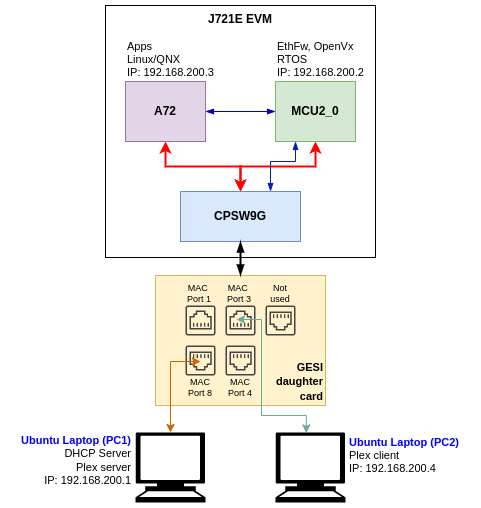Ethernet firmware is integrated part of vision_apps and enabled by default. One can run all the OpenVx based demos alongside with Ethfw running on CPSW9G IP on J7ES EVM.
j7-evm login: root
Last login: Mon Nov 29 14:43:33 UTC 2021
root@j7-evm:~# source /opt/vision_apps/vision_apps_init.sh
...
...
[MCU2_0] 17.235797 s: ETHFW: Init ... !!!
[MCU2_0] 17.256561 s: ETHFW: Shared multicasts (software fanout):
[MCU2_0] 17.256629 s: 01:00:5e:00:00:01
[MCU2_0] 17.256683 s: 01:00:5e:00:00:fb
[MCU2_0] 17.256729 s: 01:00:5e:00:00:fc
[MCU2_0] 17.256772 s: 33:33:00:00:00:01
[MCU2_0] 17.256815 s: 33:33:ff:1d:92:c2
[MCU2_0] 17.256858 s: 01:80:c2:00:00:00
[MCU2_0] 17.256900 s: 01:80:c2:00:00:03
[MCU2_0] 17.256945 s: ETHFW: Reserved multicasts:
[MCU2_0] 17.256981 s: 01:80:c2:00:00:0e
[MCU2_0] 17.257029 s: 01:1b:19:00:00:00
[MCU2_0] 17.257269 s: EnetMcm: CPSW_9G on MAIN NAVSS
[MCU2_0] 17.268444 s: PHY 0 is alive
[MCU2_0] 17.268525 s: PHY 3 is alive
[MCU2_0] 17.268575 s: PHY 12 is alive
[MCU2_0] 17.268612 s: PHY 15 is alive
[MCU2_0] 17.268655 s: PHY 23 is alive
[MCU2_0] 17.268948 s: EnetPhy_bindDriver: PHY 12: OUI:080028 Model:23 Ver:01 <-> 'dp83867' : OK
[MCU2_0] 17.269237 s: EnetPhy_bindDriver: PHY 0: OUI:080028 Model:23 Ver:01 <-> 'dp83867' : OK
[MCU2_0] 17.269530 s: EnetPhy_bindDriver: PHY 3: OUI:080028 Model:23 Ver:01 <-> 'dp83867' : OK
[MCU2_0] 17.269796 s: EnetPhy_bindDriver: PHY 15: OUI:080028 Model:23 Ver:01 <-> 'dp83867' : OK
[MCU2_0] 17.271513 s:
[MCU2_0] ETHFW Version : 0.02.00
[MCU2_0] 17.271583 s: ETHFW Build Date: Dec 6, 2021
[MCU2_0] 17.271616 s: ETHFW Build Time: 13:05:54
[MCU2_0] 17.271643 s: ETHFW Commit SHA: 55d0bef1
[MCU2_0] 17.271710 s: ETHFW: Init ... DONE !!!
[MCU2_0] 17.271742 s: ETHFW: Remove server Init ... !!!
[MCU2_0] 17.271916 s: CpswProxyServer: Virtual port configuration:
[MCU2_0] 17.271981 s: mpu_1_0 <-> Switch port 0: mpu_1_0_ethswitch-device-0
[MCU2_0] 17.272031 s: mcu_2_1 <-> Switch port 1: mcu_2_1_ethswitch-device-1
[MCU2_0] 17.272076 s: mpu_1_0 <-> MAC port 1: mpu_1_0_ethmac-device-1
[MCU2_0] 17.272115 s: mcu_2_1 <-> MAC port 4: mcu_2_1_ethmac-device-4
[MCU2_0] 17.273139 s: CpswProxyServer: initialization completed (core: mcu2_0)
[MCU2_0] 17.273207 s: ETHFW: Remove server Init ... DONE !!!
[MCU2_0] 17.274312 s: Starting lwIP, local interface IP is dhcp-enabled
[MCU2_0] 17.280756 s: Host MAC address: 70:ff:76:1d:92:c3
[MCU2_0] 17.284536 s: [LWIPIF_LWIP] Enet LLD netif initialized successfully
[MCU2_0] 17.316149 s: [LWIPIF_LWIP_IC] Interface started successfully
[MCU2_0] 17.316220 s: [LWIPIF_LWIP_IC] NETIF INIT SUCCESS
[MCU2_0] SNo. IP Address MAC Address
[MCU2_0] 22.675608 s: ------ ------------- -----------------
[MCU2_0] 22.675643 s: 1 192.168.1.216 70:ff:76:1d:92:c1
[MCU2_0] 22.677839 s: Function:CpswProxyServer_filterAddMacHandlerCb,HostId:0,Handle:a37e1074,CoreKey:38acb7e6, MacAddre0
[MCU2_0] 22.679926 s: Function:CpswProxyServer_filterAddMacHandlerCb,HostId:0,Handle:a37e1074,CoreKey:38acb7e6, MacAddre0
[MCU2_0] 25.274278 s: Added interface 'br4', IP is 192.168.1.219
[MCU2_0] 25.287624 s: EthFw: TimeSync PTP enabled
[MCU2_0] 25.293106 s: Rx Flow for Software Inter-VLAN Routing is up
You are now ready to run any of the OpenVx applications including DL applications using the SDK.
